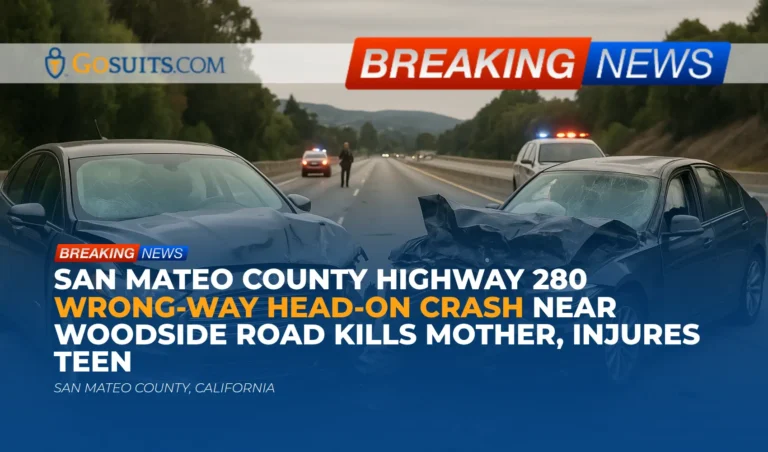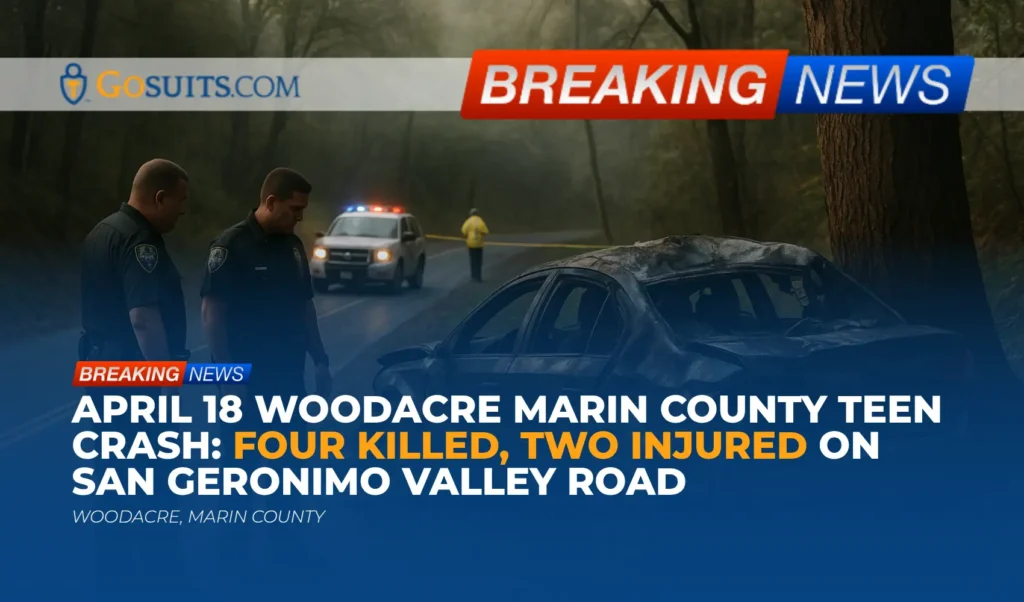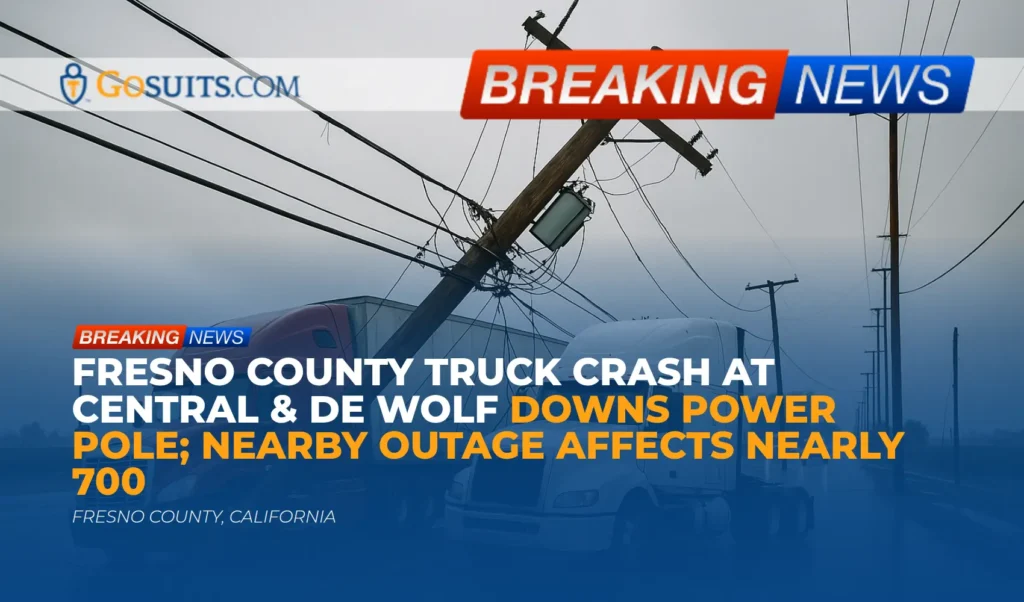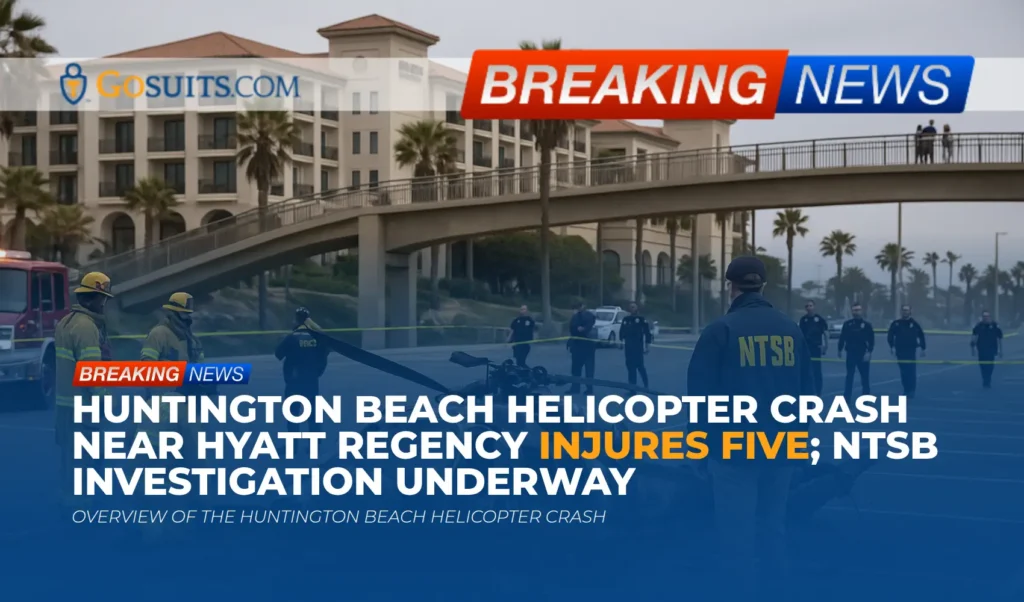- What happened on Highway 280 in San Mateo County
- What authorities have reported so far
- Civil law context after a wrong-way head-on collision in California
- Rights of injured minors in California crashes
- Wrongful death claims for families
- Insurance pathways that may apply
- Records to request and where to get them
- Evidence preservation and documentation tips
- Important deadlines in California civil cases
- Safety background on wrong-way and impaired driving
- Practical steps to consider before dealing with insurance companies
- Why taking action matters now
- Commentary from Gosuits San Mateo County, California Personal Injury Attorney
What happened on Highway 280 in San Mateo County
Authorities report that on the afternoon of April 22, 2023, a Ford Fusion traveling the wrong way on southbound Highway 280 near the Woodside Road exit collided head-on with a BMW. The crash killed a 54-year-old San Francisco woman, identified publicly as Eden Palmer, and seriously injured her 16-year-old son, who was a passenger. The family dog also died. The mother was reportedly driving her son to a soccer match on the Peninsula when the collision occurred.
Prosecutors stated that the wrong-way driver, a 26-year-old Campbell resident, later pleaded no contest to felony vehicular manslaughter and felony reckless driving with a great-bodily-injury enhancement. The vehicular manslaughter charge includes a hit-and-run enhancement. According to the San Mateo County District Attorney’s Office, the defendant remains in custody without bail pending sentencing. Law enforcement indicated she fled the scene and was located nearby. A subsequent blood test showed evidence of marijuana in her bloodstream, according to the reports; she declined field sobriety testing at the scene.
This article focuses on the civil injury and wrongful death aspects for those affected by a wrong-way collision of this nature. Our aim is to explain in clear terms what rights may be available, how key records can be requested, and what steps can safeguard claims, while staying respectful of the loss and trauma reported.
What authorities have reported so far
Location and direction of travel
Officials indicated that the Ford Fusion entered southbound lanes of Highway 280 traveling northbound, leading to a head-on collision just north of the Woodside Road exit in San Mateo County. California’s Vehicle Code prohibits driving on the wrong side of a divided highway. The rule exists to protect against the exact type of violent head-on collision described in the reports. See California Vehicle Code section 21651 for the prohibition on driving on the wrong side of divided highways, available through the state’s legal portal at leginfo.legislature.ca.gov.
Injuries and losses reported
Law enforcement and prosecutors have stated that the collision caused the death of the mother and catastrophic injuries to her teenage son, who will reportedly have ongoing medical needs. The family’s dog died at the scene. The profound emotional and practical impact of such a loss can be immense. In the civil system, serious injury and wrongful death claims are designed to address medical costs, lifelong care needs, funeral and burial costs, and other harms permitted by California law, as explained below.
Civil law context after a wrong-way head-on collision in California
Potential liability and negligence per se
In a civil personal injury or wrongful death case, the injured party or family generally needs to show that another party breached a duty of care and that this breach caused injury or loss. Driving the wrong way on a divided highway violates California Vehicle Code section 21651. When a safety statute is violated and the violation causes the type of harm the statute is designed to prevent, California’s negligence per se doctrine may apply in civil court. In practical terms, traveling the wrong way into oncoming lanes commonly satisfies the breach element, shifting the focus to causation and damages. While every case requires proof, head-on collisions from wrong-way travel often present strong liability facts.
California also imposes a duty to remain at the scene and render aid in crashes causing injury or death. See Vehicle Code section 20001 at leginfo.legislature.ca.gov. Evidence of fleeing can be relevant to civil claims, including potential punitive damages in limited circumstances where the conduct demonstrates malice or a conscious disregard for safety. Whether a particular case supports punitive damages is fact- and law-intensive and evaluated on a case-by-case basis.
Hit-and-run considerations in civil claims
In a civil claim following an injury or death, the fact that a driver allegedly fled may impact the evaluation of liability, available insurance coverage, and, sometimes, the availability of punitive damages. Separate from civil claims, California’s criminal and traffic laws address hit-and-run duties. For civil purposes, documentation that the driver left without rendering aid can be a significant factor considered by juries and insurers when assessing fault and damages, alongside all other evidence.
Comparative fault in California
California uses pure comparative fault, meaning a plaintiff’s compensation can be reduced by any percentage of fault attributed to them. However, in wrong-way head-on collisions on divided highways, evidence often points strongly to the wrong-way driver as the primary cause. Each case turns on its facts, and claimants are not required to prove perfect conduct—only that the other party’s negligence substantially caused the harm. The focus in a scene like the one described is usually on the actions that placed a vehicle traveling against traffic into oncoming lanes.
Rights of injured minors in California crashes
When a minor suffers injuries, California courts provide special safeguards for any settlement of claims. Typically, a parent or guardian acts on behalf of the child, and a judge must approve any settlement to ensure it is fair and that funds are protected for the child’s needs. The California Courts Self-Help Center provides general information about resolving a child’s injury claim and court approval of a minor’s compromise at selfhelp.courts.ca.gov.
Key points for child injury cases include documenting all medical care, consulting qualified medical providers about long-term care needs, and ensuring any structured settlement or trust vehicle complies with court requirements for safeguarding the child’s funds through adulthood.
Wrongful death claims for families
Who may bring a wrongful death claim
California law allows specified family members to bring a wrongful death claim for the loss of a loved one caused by another’s negligence or wrongful act. The claim is meant to compensate for losses such as the loss of the decedent’s financial support, household services, guidance, and companionship. In addition to wrongful death, the decedent’s estate may bring a survival action for certain damages the decedent incurred before passing. While the specific eligible parties and recoverable damages are defined by statute and case law, surviving spouses, children, and sometimes other dependents are typical claimants.
Damages commonly sought
- Economic losses: funeral and burial expenses; loss of financial support and benefits; loss of household services; and medical expenses incurred before death where applicable.
- Non-economic losses: loss of love, companionship, comfort, care, assistance, protection, affection, society, and moral support. California does not permit recovery for a survivor’s grief itself, but the loss of the relationship is compensable.
- Survival action damages: in some cases, the estate may recover economic losses the decedent sustained before death and, when supported by law and evidence, punitive damages for the decedent’s injuries suffered prior to passing.
The facts described by authorities here, if established in civil court, align with the types of losses that wrongful death and survival statutes were designed to address.
Insurance pathways that may apply
At-fault driver liability insurance
Claims are typically brought against the at-fault driver’s liability insurance. In a wrong-way, head-on scenario, liability carriers often accept responsibility but may dispute the extent of damages or future care needs. Documentation of injuries, treatment plans, and long-term costs is critical. For families pursuing wrongful death, proof of economic support and household services is equally important.
Uninsured/underinsured motorist (UM/UIM) coverage
UM/UIM coverage on the family’s own auto policy can help when the at-fault driver has no insurance or too little to cover damages. In a catastrophic loss, underinsurance is common. UM/UIM claims have unique notice and proof requirements, and policy language matters. If a UM/UIM claim is contemplated, it is prudent to consult an attorney first, because communications to any insurer can be used to limit claims later. California’s Office of Traffic Safety and NHTSA both note the continued prevalence of serious traffic injuries and fatalities, which often strain available liability limits. See NHTSA’s general impaired driving overview at nhtsa.gov.
Medical payments (MedPay) benefits
Some auto policies provide MedPay benefits that cover medical bills regardless of fault. These benefits may help address immediate expenses for an injured passenger, including a minor. MedPay can interact with health insurance and subrogation rights, so understanding policy terms is important before submitting claims.

Health insurance and subrogation
Health insurers typically pay medical bills but may assert a right to reimbursement from any third-party settlement. The scope of reimbursement and any reductions can depend on state and federal law, as well as the specifics of the plan. Careful coordination can help ensure funds are used for present and future care with minimal disruption.
Records to request and where to get them
Official records help establish fault, injuries, and damages. Several agencies may hold key documents. Where applicable, we include government resources that explain how to request these materials.
California Highway Patrol collision report (Highway 280)
Because the crash occurred on a state highway, the California Highway Patrol (CHP) generally investigates. A collision report can be requested using CHP’s process and form CHP 190 (typically for involved parties or their representatives). Visit the CHP website to locate the appropriate area office and request procedures at chp.ca.gov and the Find an Office page at chp.ca.gov/find-an-office. The form and instructions are commonly available under CHP forms. Identification, proof of involvement, and a fee may be required.
Coroner and autopsy records
In fatal crashes, the county coroner or medical examiner typically investigates the cause and manner of death and may generate reports, autopsy findings, and toxicology. The coroner for the county where the death occurred maintains those records. Families can contact the county coroner’s office to ask about next steps, required forms, costs, and processing timelines. Because each county maintains its own process and portal, check the official county government website for San Mateo County to locate the coroner division’s instructions and contact information.
Death certificates
Certified copies of a death certificate in California may be requested through the California Department of Public Health’s Vital Records program or through the county recorder. Instructions are available on the CDPH site at cdph.ca.gov. Certified copies are often needed for insurance and probate matters.
Medical records and billing
Hospitals and treating providers maintain medical records and bills. Federal regulations give individuals the right to access their medical records. The U.S. Department of Health and Human Services provides a plain-language overview of how to request records under HIPAA at hhs.gov. For minors, a parent or legal guardian typically requests records on the child’s behalf. Save all insurance explanations of benefits (EOBs), out-of-pocket receipts, and travel logs for medical appointments.
911 calls, dispatch logs, traffic camera footage
Some local agencies retain 911 audio and dispatch logs for limited periods. Requests can be made under California’s Public Records Act. The California Attorney General provides general guidance on records requests at oag.ca.gov. Timeliness matters because agencies may routinely delete or overwrite recordings on short cycles. If roadway cameras or Caltrans traffic management center video may exist, asking promptly can make a difference. Caltrans information about traffic operations can be found at dot.ca.gov.
Criminal court materials and victim assistance
Where there is a related criminal case, minute orders, sentencing dates, and victim restitution information may be available through the county court. California Courts offer general information about crime victims’ rights and restitution at selfhelp.courts.ca.gov. In some situations, the California Victim Compensation Board may assist eligible victims with certain crime-related expenses; see victims.ca.gov for program details.
Evidence preservation and documentation tips
- Photographs and video: Collect and safely store photos of the scene, vehicle damage, injuries, and recovery progress. Timestamped images are useful.
- Witness information: Preserve names, phone numbers, and any statements from witnesses who saw the wrong-way vehicle or the collision sequence.
- Vehicle data: Many vehicles contain event data recorders (EDRs) that may store speed, braking, and other information. Discuss quickly with counsel and your insurer about preserving vehicles and data if a claim is contemplated.
- Medical timeline: Keep a detailed log of symptoms, appointments, diagnoses, prescriptions, therapies, and physician recommendations. For severe injuries, ask doctors to estimate future care needs and likely costs.
- Economic documentation: Gather pay stubs, tax records, and employer statements to establish loss of income or support. For household services, list chores and caregiving tasks the decedent performed and replacement costs.
- Grief and impact statements: In wrongful death claims, non-economic loss is shown through the lived experience of family members. Journals and written statements can help document the day-to-day effects of the loss.
Important deadlines in California civil cases
Two-year statute of limitations for injury and wrongful death
Most personal injury and wrongful death lawsuits in California must be filed within two years of the date of injury or death. See Code of Civil Procedure section 335.1 at leginfo.legislature.ca.gov. There are exceptions and rules that can shorten or extend deadlines in certain circumstances, including when minors are involved or when a government entity is a potential defendant.
Six-month government claim deadline if a public entity may be involved
If an investigation suggests a potential roadway design, signage, or maintenance defect involving a public entity (for example, a wrong-way entry at a ramp lacking appropriate countermeasures), California’s Government Claims Act generally requires a written claim to be filed within six months of the incident. See Government Code section 911.2 at leginfo.legislature.ca.gov. This procedural step is required before filing a civil lawsuit against a public entity and has strict content and timing requirements. Whether such a claim is appropriate depends on engineering and factual analysis.
Safety background on wrong-way and impaired driving
Wrong-way crashes, while relatively infrequent, are disproportionately deadly because they often result in head-on impacts at highway speeds. Federal safety agencies have studied countermeasures such as enhanced ramp signing, wrong-way detection systems, and high-visibility pavement markings to reduce incidence and severity. The Federal Highway Administration summarizes wrong-way safety strategies and engineering approaches on its safety pages, and state-level pilot programs like those by Caltrans have deployed additional technology and signage at high-risk ramps. See Caltrans traffic operations resources at dot.ca.gov and FHWA’s roadway safety materials at safety.fhwa.dot.gov.
Impairment remains a significant factor in severe crashes across the United States. NHTSA provides data and prevention guidance regarding alcohol- and drug-impaired driving at nhtsa.gov. Research by federal and state agencies has found that multilayered countermeasures—engineering, enforcement, education, and emergency response—are most effective in reducing serious traffic injuries and fatalities. The reported facts in this collision underscore the importance of these measures on high-speed corridors like Interstate 280.

Practical steps to consider before dealing with insurance companies
- Speak with a qualified attorney first: Before giving a recorded statement or signing any medical authorizations for any insurer, consider a free consultation to understand rights and obligations. What is said to an insurance company can be used later to limit or deny claims.
- Control the flow of information: Provide insurers with essential claim information after you have a plan. Broad medical releases can result in disclosure of unrelated history and may complicate the claim evaluation.
- Coordinate benefits: If MedPay, UM/UIM, health insurance, and liability coverage may all be involved, a coordinated strategy helps avoid gaps, duplicates, or unintended reimbursement issues.
- Document all communications: Keep a log of calls, emails, adjuster names, claim numbers, and any promises or deadlines stated by insurers.
- Value future needs: In cases of serious injury, build a record of long-term therapies, surgeries, home modifications, mobility aids, and attendant care. Life-care planning opinions can be important in larger claims.
Why taking action matters now
- Preserve time-sensitive evidence: Traffic camera footage, 911 recordings, and vehicle event data can be overwritten in days or weeks. Early requests and preservation letters can make the difference between having direct evidence and relying only on memory.
- Protect against missed deadlines: California’s two-year statute for injury and wrongful death claims is the outer limit for most cases, but special deadlines (such as the six-month government claim requirement) can be much shorter.
- Ensure accurate medical documentation: Early, consistent medical treatment creates a clear record of injury, causation, and prognosis. Delays can be misinterpreted by insurers and reduce settlement value.
- Establish financial stability: Early claims for available benefits, such as MedPay or victim compensation programs, can help stabilize immediate costs like funeral expenses or co-pays while longer claims progress.
- Avoid harmful statements: Insurance adjusters may seek recorded statements quickly. Having guidance before engaging can prevent misunderstandings and preserve the full scope of recoverable losses.
- Assess all potential defendants: Prompt investigation can reveal additional responsible parties, from vehicle owners to potential roadway maintenance entities, ensuring claims are directed appropriately and on time.
Commentary from Gosuits San Mateo County, California Personal Injury Attorney
Our hearts go out to the family affected by this devastating wrong-way collision, and to the injured teenager facing a long recovery. This commentary is intended for general information and education. Based on the reported facts, the collision appears to have been caused by a vehicle traveling against traffic on a divided highway and then leaving the scene. In civil terms, that combination often creates a very strong liability picture, particularly for head-on impacts where forces are severe and injuries catastrophic. The reported need for lifelong medical care for a teenager underscores the importance of careful, forward-looking damage assessment.
In our experience, insurers and large corporations often leverage the complexity of the process to their advantage. They may ask for broad medical authorizations, request recorded statements, or make quick, partial offers before the full scope of injuries and losses is known. Particularly where a minor has been harmed or a family has suffered a death, early offers rarely reflect future medical needs, lost support, or the profound loss of a parent. It is common to see disputes about long-term care costs, home modifications, and the value of household services the decedent provided.
Free consultations serve an important educational purpose. They allow people to understand timelines, what records to gather, which benefits to activate, and how to avoid common pitfalls that can limit recovery. Before speaking with any insurance company, it is wise to get oriented, understand the implications of statements and releases, and develop a plan that protects the rights of those harmed.
Government and academic resources cited
- California Vehicle Code § 21651 (wrong-way driving on divided highways)
- California Vehicle Code § 20001 (duty to stop at the scene of an injury/death collision)
- Code of Civil Procedure § 335.1 (two-year statute for injury/wrongful death)
- Government Code § 911.2 (six-month claim requirement for public entities)
- California Highway Patrol (collision reports and local area office contacts)
- California Courts and California Courts Self-Help (general information for crime victims and minors’ settlements)
- California Department of Public Health – Vital Records (death certificates)
- California Attorney General – Public Records Act (how to make records requests)
- California Victim Compensation Board (victim services and reimbursement programs)
- U.S. HHS – Access to Medical Records (HIPAA rights and request process)
- NHTSA – Impaired Driving (national safety data and prevention)
- Caltrans and FHWA Safety (wrong-way and roadway safety resources)






